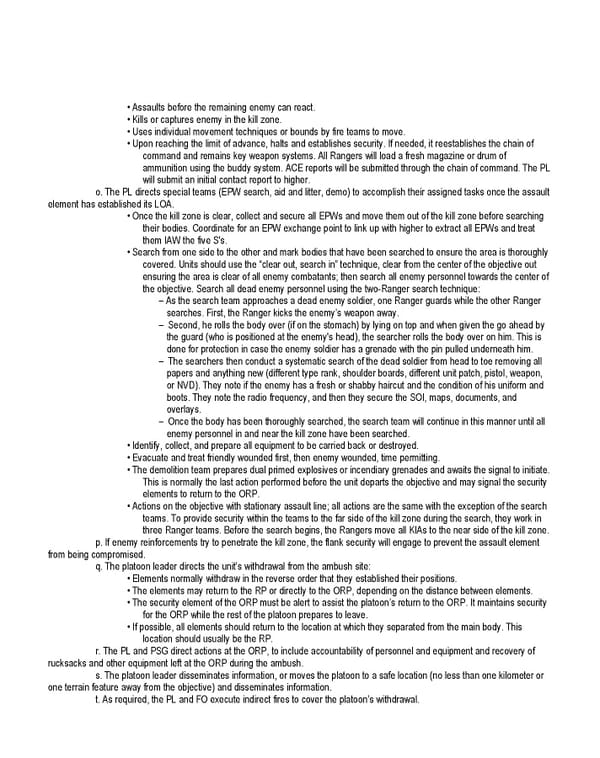• Assaults before the remaining enemy can react. • Kills or captures enemy in the kill zone. • Uses individual movement techniques or bounds by fire teams to move. • Upon reaching the limit of advance, halts and establishes security. If needed, it reestablishes the chain of command and remains key weapon systems. All Rangers will load a fresh magazine or drum of ammunition using the buddy system. ACE reports will be submitted through the chain of command. The PL will submit an initial contact report to higher. o. The PL directs special teams (EPW search, aid and litter, demo) to accomplish their assigned tasks once the assault element has established its LOA. • Once the kill zone is clear, collect and secure all EPWs and move them out of the kill zone before searching their bodies. Coordinate for an EPW exchange point to link up with higher to extract all EPWs and treat them IAW the five S's. • Search from one side to the other and mark bodies that have been searched to ensure the area is thoroughly covered. Units should use the “clear out, search in” technique, clear from the center of the objective out ensuring the area is clear of all enemy combatants; then search all enemy personnel towards the center of the objective. Search all dead enemy personnel using the two-Ranger search technique: – As the search team approaches a dead enemy soldier, one Ranger guards while the other Ranger searches. First, the Ranger kicks the enemy’s weapon away. – Second, he rolls the body over (if on the stomach) by lying on top and when given the go ahead by the guard (who is positioned at the enemy's head), the searcher rolls the body over on him. This is done for protection in case the enemy soldier has a grenade with the pin pulled underneath him. – The searchers then conduct a systematic search of the dead soldier from head to toe removing all papers and anything new (different type rank, shoulder boards, different unit patch, pistol, weapon, or NVD). They note if the enemy has a fresh or shabby haircut and the condition of his uniform and boots. They note the radio frequency, and then they secure the SOI, maps, documents, and overlays. – Once the body has been thoroughly searched, the search team will continue in this manner until all enemy personnel in and near the kill zone have been searched. • Identify, collect, and prepare all equipment to be carried back or destroyed. • Evacuate and treat friendly wounded first, then enemy wounded, time permitting. • The demolition team prepares dual primed explosives or incendiary grenades and awaits the signal to initiate. This is normally the last action performed before the unit departs the objective and may signal the security elements to return to the ORP. • Actions on the objective with stationary assault line; all actions are the same with the exception of the search teams. To provide security within the teams to the far side of the kill zone during the search, they work in three Ranger teams. Before the search begins, the Rangers move all KIAs to the near side of the kill zone. p. If enemy reinforcements try to penetrate the kill zone, the flank security will engage to prevent the assault element from being compromised. q. The platoon leader directs the unit’s withdrawal from the ambush site: • Elements normally withdraw in the reverse order that they established their positions. • The elements may return to the RP or directly to the ORP, depending on the distance between elements. • The security element of the ORP must be alert to assist the platoon’s return to the ORP. It maintains security for the ORP while the rest of the platoon prepares to leave. • If possible, all elements should return to the location at which they separated from the main body. This location should usually be the RP. r. The PL and PSG direct actions at the ORP, to include accountability of personnel and equipment and recovery of rucksacks and other equipment left at the ORP during the ambush. s. The platoon leader disseminates information, or moves the platoon to a safe location (no less than one kilometer or one terrain feature away from the objective) and disseminates information. t. As required, the PL and FO execute indirect fires to cover the platoon’s withdrawal.
 Ranger Handbook Page 125 Page 127
Ranger Handbook Page 125 Page 127